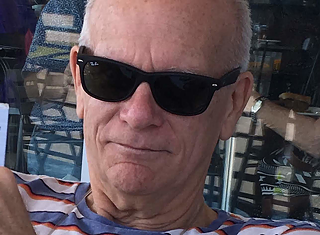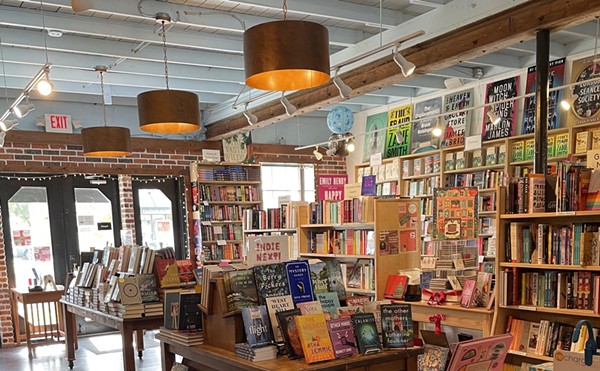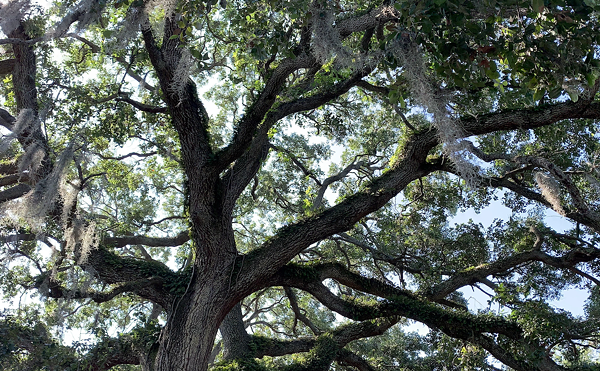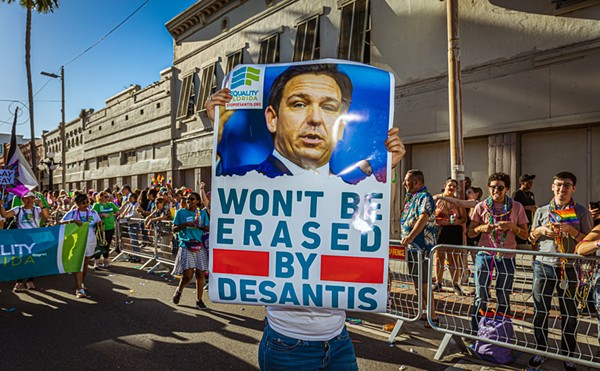Linda Saul-Sena, who currently sits on the City Council, was also a member in the late '80s. As prospective bar owners paraded in front of the dais to get their go-ahead to sell liquor, she was incredulous. Backed by a handful of the district's artist/activists, she and council member Scott Paine urged caution. But the council wielded its rubber stamp, consistently voting 5-2 in favor of new wet zonings.
"It became a why-not thing," Saul-Sena says. "We approved the first 20, why not approve the next 20? There was this sense of profit potential."
"Neither the council nor the mayor was inclined to exert control over a place that was generating a lot of revenues, pushing up real estate values and filling empty spaces," says urban planner Michael English, an early participant in Ybor's artist renaissance.
What resulted was growth without a long-term clue. The Ybor development agency's Community Redevelopment Plan, ratified in 1988 and expiring in June, encouraged growing the "commercial core." It did not, however, recommend filling the place with bars.
Nineteen ninety one. Consensus says it was Year One of the Ybor gold rush. Nightclub owners played connect-the-dots along Seventh Avenue. And the hordes came. Along with them came a sense of civic pride. For a town like Tampa with longstanding identity problems about its status as a major city, a thriving entertainment district seemed to prove that it was in the same league as New Orleans and Miami and Seattle. In 1995, the city closed several blocks of Seventh to cars, cementing the district's status as a party zone.And, for quite a few years, it was really fun. A panoply of folk congregated in Ybor to revel in the distractions. Those not inclined to simply drink till they fell down could take in live music at the Blues Ship, the Jazz Cellar, the Rubb and other clubs. They could gather in more intimate places like Atomic Age Cafe and Lounge, Z-Spot and Ovo Cafe.
Storefronts sprung to life: From 1990 to 1996, 130 new businesses opened in Ybor; 50 opened in '94 alone.
It wasn't just about letting the good times roll, though. The city, which opened the floodgates without much of a blueprint, was slow to deal with surging problems: Garbage pickup wasn't adequate; crowd management was a struggle; the noise ordinance became a divisive issue.
Except for a hearty few, the artist colony bailed. Rents had more than doubled, and the hassle factor had increased exponentially. Worse, Ybor City's bohemian identity vanished. Brad Cooper still runs his spacious Brad Cooper Gallery next door to Green Iguana. An early Ybor pioneer who set up an apartment adjacent to his business, he eventually had to vacate due to health problems. "I developed a sleep disorder," he says. Many of the district's unique shops and small eateries were forced out due to skyrocketing rents. Blues Ship, Jazz Cellar, The Rubb and other live-music clubs folded.
Around the turn of the millennium, Ybor City no longer deserved to be called an entertainment district. A drinking mall, maybe.
To its credit, the city has taken a more proactive role in Ybor in recent years, with varying degrees of success. The place is spiffier now, thanks in large part to a city-generated "Clean Team," which picks up litter.Centro Ybor, a $40-million mall hailed by Mayor Dick Greco as the final piece in the Ybor puzzle, opened in October 2000. But the facility has experienced extended growing pains. While some of its businesses, like the Improv comedy club, attract crowds and add to the cultural fabric, more places struggle. Chain stores like American Eagle and Pac Sun represent the kind of overt commercialism that was disdained in the district. Many of Centro Ybor's 20 movie theaters sit nearly empty.
Parking used to be a nightmare in Ybor. As more and more cars clogged in, owners of vacant lots gouged customers for $10 and up. The district now includes two well-lighted municipal garages that charge modest fees. Pardo claims that parking problems in Ybor City effectively "no longer exist." The new streetcar that runs between Channelside, downtown and Ybor adds a quaint element, as well as convenient transportation.
At the same time, the city has made some bonehead moves with regard to the district. During much of the mid '90s heyday, Ybor's streets were peppered with small vendors and street performers, which added to the overall vibrancy. In '98, the city shut the small guys out. District denizens can understand why little merchants were eliminated to protect storefront businesses (although they may not agree) but still wonder why the guy with the plastic paint cans can't set 'em up and drum away. Losing the buskers sucked some of the freaky character out of the strip.

















